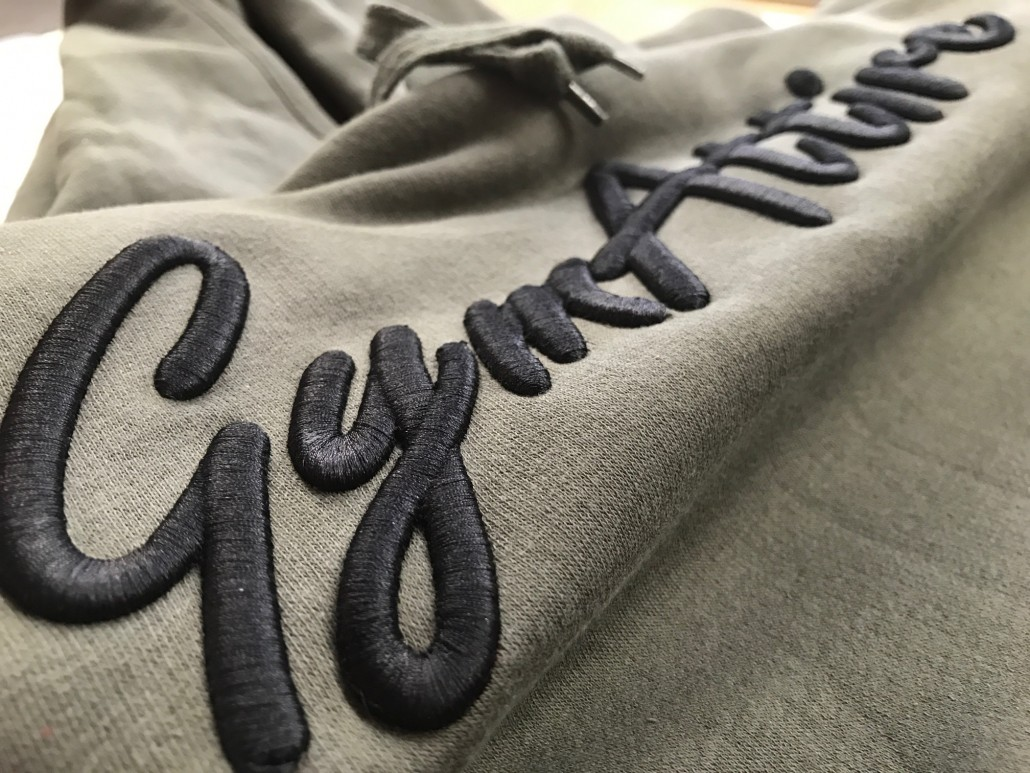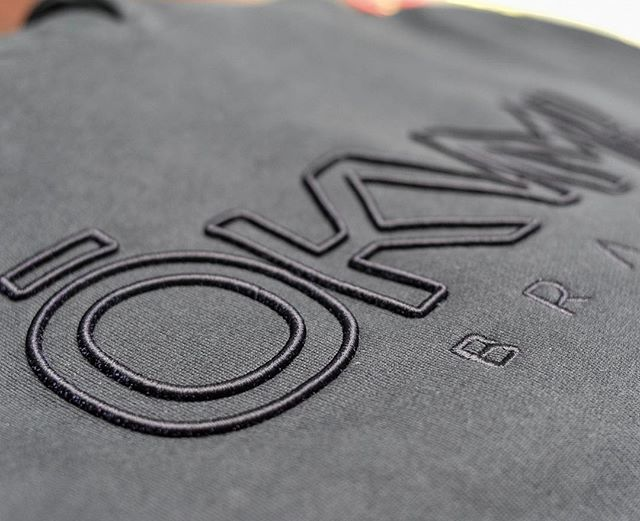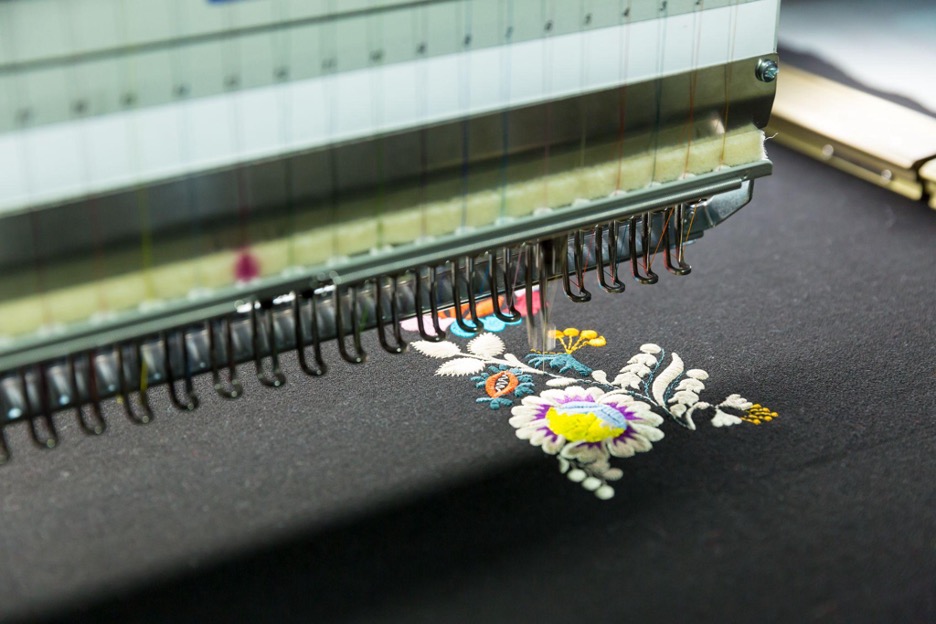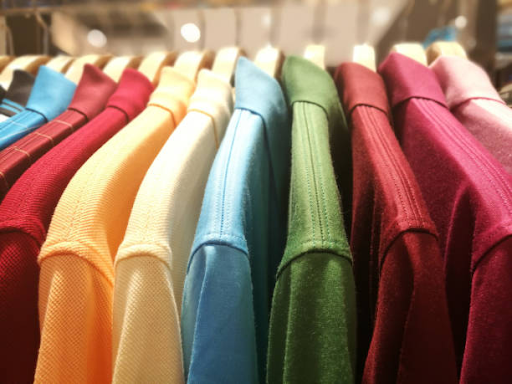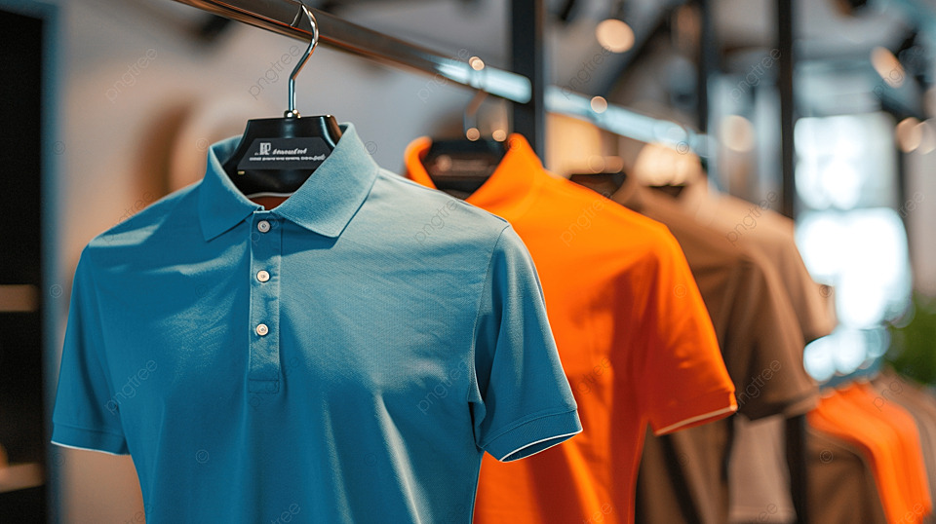Looking For 3D Embroidery Services In Singapore?
At EMB3 Pte Ltd, we specialize in delivering premium 3D embroidery services that elevate your brand with unmatched craftsmanship. Whether you’re looking to add dimension to corporate uniforms, promotional items, or personalized gifts, our team combines cutting-edge technology with expert design to create vibrant, high-quality 3D embroidered logos and patterns.
Based in Singapore, we serve clients across industries with customized solutions that reflect attention to detail and precision. From intricate designs to bold, standout logos, EMB3 ensures your vision is brought to life in every stitch. Transform your apparel and merchandise with our top-tier 3D embroidery services today.
Contact us now
for 3D Embroidery Services!
or
What is 3D Embroidery?
(Source: Colman & Company)
3D embroidery is a technique that involves adding three-dimensional elements to embroidered designs, creating a tactile and visually striking effect. Unlike traditional embroidery, which is generally flat, 3D embroidery uses various materials and techniques to bring depth and texture to the artwork. This technique adds an extra dimension to the art form, making it stand out and captivating viewers.
Benefits and Applications of 3D Embroidery
(Source: Calder Ltd)
3D embroidery offers several benefits and finds applications in various fields. Some of the key advantages include:
1. Enhanced texture and visual impact
The added dimensionality of 3D embroidery creates a visually stunning effect, capturing attention and adding depth to the design.
2. Realistic representation
With 3D embroidery, it is possible to replicate the look and feel of three-dimensional objects, such as flowers, animals, or architectural details, with greater realism.
3. Versatility in material usage
3D embroidery allows for the incorporation of a wide range of materials, such as foam, fabric, beads, or sequins, to create different textures and effects.
4. Branding and personalization
The use of 3D embroidery is widespread in the branding industry, as it helps logos and designs stand out and leave a memorable impression. It is also utilized in personalizing garments, accessories, and home decor items.
5. Artistic expression
3D embroidery opens up new possibilities for creative expression and experimentation, enabling artists and crafters to push the boundaries of traditional embroidery and create unique, eye-catching pieces.
What is the Difference Between 3D Embroidery and Normal Embroidery?
(Source: Coastal Reign & IO.WP)
The main difference between 3D embroidery and normal embroidery lies in the techniques and materials used to create a three-dimensional effect in the design.
1. Dimensionality
In normal embroidery, the design is typically stitched onto a flat surface, and the focus is on creating detailed and visually appealing two-dimensional designs. On the other hand, 3D embroidery aims to add depth, texture, and a sense of three-dimensionality to the design. It involves incorporating additional materials like foam, fabric, beads, or sequins to create raised elements or layered textures, making the embroidery visually pop out from the surface.
2. Techniques
Normal embroidery primarily utilizes flat stitches, such as satin stitches, running stitches, or fill stitches, to create the design. These stitches lie flat on the fabric and are meant to enhance the visual appeal of the two-dimensional design. In contrast, 3D embroidery incorporates techniques like padded satin stitches, which build up layers of stitching to create raised elements, or techniques like couching and cording, which add raised outlines and accents to the design. These techniques add depth and texture to the embroidery, giving it a three-dimensional appearance.
3. Materials
While normal embroidery typically involves stitching with thread onto fabric, 3D embroidery introduces additional materials to create the desired effects. Foam is commonly used to create raised elements, fabric pieces are layered and stitched to add dimension, and beads, sequins, or other embellishments are incorporated for added texture and visual interest. These materials work in conjunction with the embroidery stitches to achieve the three-dimensional effect.
Overall, the difference between 3D embroidery and normal embroidery lies in the intention and execution. 3D embroidery aims to go beyond the flat surface, adding depth and dimension to the design through the use of additional materials and specialized stitching techniques. It allows for a more tactile and visually striking outcome, making the embroidery stand out and capturing attention.
What are the Types of 3D Embroidery?
(Source: GoShoppi)
There are several types of 3D embroidery techniques that can be used to create different effects and add dimension to designs. Here are some common types of 3D embroidery:
1. Foam Embroidery
This technique involves using foam as a material to create raised elements in the design. Foam sheets or pre-cut foam shapes are layered and stitched onto the fabric, giving the embroidery a three-dimensional appearance.
2. Appliqué Embroidery
Appliqué is a technique where fabric pieces are cut out and stitched onto the base fabric, creating raised or layered elements. The fabric pieces can be shaped, layered, or even stuffed to add volume and dimension to the design.
3. Padded Satin Stitch
Padded satin stitches are used to create raised areas in the design. A layer of padding material, such as extra thread or foam, is stitched down first, and then satin stitches are applied over it. This technique adds depth and dimension to specific areas of the design.
4. Bead and Sequin Embroidery
Beads and sequins can be incorporated into the embroidery design to add texture and shine. They can be individually stitched onto the fabric or attached using specialized techniques like beading or sequin embroidery. Beads and sequins can be used to create raised elements or to enhance specific details in the design.
5. Cording and Couching
Cording and couching techniques involve attaching cords or thicker threads onto the fabric using stitching. These techniques are used to create raised outlines, contours, or accents in the design. The cords are typically stitched over or alongside the design elements to give them depth and dimension.
6. Raised Fill Stitches
Raised fill stitches are used to create textured and three-dimensional backgrounds or surfaces. These stitches can include techniques like seed stitch, French knots, or variations of the satin stitch, where stitches of varying lengths or densities are used to add texture and dimension to the filled areas.
These are just a few examples of the types of 3D embroidery techniques available. The choice of technique depends on the desired effect and the specific design being embroidered. By combining different techniques and materials, embroiderers can create unique and visually striking 3D embroidery pieces.
Can Any Design Be Turned into 3D Embroidery?
(Source: Youtube)
Not all designs are suitable for 3D embroidery. The feasibility of turning a design into 3D embroidery depends on the elements and characteristics of the design itself. Here are some factors to consider:
1. Design Complexity
Intricate and highly detailed designs may not translate well into 3D embroidery, as the additional materials and techniques could overwhelm or obscure the design elements. Simple or bold designs with distinct shapes and lines are generally more suitable for 3D embroidery.
2. Elements with Dimensional Potential
Designs that include elements that can be easily translated into three-dimensional forms, such as flowers, animals, or objects with distinct shapes, tend to work well for 3D embroidery. These elements can be enhanced by adding layers, raised elements, or textured surfaces.
3. Structural Integrity
Designs with elements that require structural stability, such as letters, logos, or geometric shapes, can be challenging to convert into 3D embroidery. It’s important to consider how the added materials and techniques will affect the legibility and integrity of the design.
4. Scale and Proportion
The size and proportion of the design should be taken into account. Adding 3D elements may require more space and attention to detail. If the design is too small or intricate, the added elements might not be as visually effective.
5. Compatibility with Materials
Consider whether the design elements can be adequately represented using the available materials for 3D embroidery. Some designs may require specific textures, colors, or effects that may not be achievable with the chosen materials.
Are There Any Limitations or Challenges in 3D Embroidery?
(Source: Star Lapel Pin)
Yes, there are some limitations and challenges associated with 3D embroidery. Here are a few to consider:
1. Complexity
3D embroidery techniques can be more intricate and require additional steps compared to traditional embroidery. This complexity may pose challenges for beginners or those who are not familiar with the techniques involved. It may take time and practice to develop the necessary skills to execute 3D embroidery effectively.
2. Stability and Durability
Incorporating additional materials, such as foam, fabric, or beads, into the embroidery design introduces the challenge of maintaining stability and durability. Ensuring that the added elements are securely attached and will withstand regular use, washing, or handling requires careful consideration and skillful stitching.
3. Design Adaptation
Not all designs are well-suited for 3D embroidery. Some designs may not lend themselves to the incorporation of additional materials or may not achieve the desired 3D effect. Adapting a design to fit the requirements of 3D embroidery may involve simplifying or modifying certain elements, which can be a creative challenge.
4. Machine Limitations
If using an embroidery machine, there may be limitations in terms of the design size, hoop size, or the machine’s capability to handle certain materials. Some machines may have difficulty stitching through thick or dense materials, which can affect the feasibility of certain 3D embroidery techniques.
5. Time and Patience
Creating 3D embroidery pieces often requires more time and patience compared to regular embroidery. The additional steps, such as layering materials, shaping elements, or stitching intricate details, can be time-consuming. It’s important to allocate sufficient time and attention to achieve the desired 3D effects.
6. Washing and Care
Care should be taken when washing or cleaning 3D embroidery pieces, especially if additional materials like beads or sequins are incorporated. These materials may require special care or could be damaged during washing or dry cleaning. Following the recommended cleaning instructions for the specific materials used is important to maintain the quality and longevity of the embroidery.
Which Products Can You Choose for 3D Embroidery?
(Source: Pinterest)
3D embroidery can be applied to a wide range of products, offering versatility and customization options. Here are some products that you can consider for 3D embroidery:
1. Clothing & Apparel
Clothing items such as hats, caps, T-shirts, sweatshirts, jackets, and uniforms can be enhanced with 3D embroidery. Adding raised elements, textures, or layered designs to these garments can create visually striking and unique apparel items.
2. Fashion Accessories
Accessories like bags, backpacks, tote bags, purses, wallets, and cosmetic cases can benefit from 3D embroidery. The added dimension and texture can make these accessories more appealing and stand out in the market.
3. Headwear
Hats, caps, beanies, and visors are popular choices for 3D embroidery. The front panel or brim of a hat can be embellished with raised logos, designs, or lettering, creating a bold and eye-catching effect.
4. Home Decor
Cushion covers, pillowcases, blankets, and wall hangings can be customized with 3D embroidery. Adding textured or raised elements to home decor items can elevate their visual appeal and make them unique pieces in any living space.
5. Personalized Gifts
3D embroidery can be used to create personalized gifts for special occasions or events. Consider incorporating raised names, dates, or special messages on items like towels, robes, baby blankets, or wedding accessories to create memorable and thoughtful gifts.
6. Promotional Items
If you’re looking for unique promotional items for your business or events, 3D embroidery can be a great choice. Items like keychains, patches, badges, or promotional apparel can be enhanced with 3D elements, making them more memorable and impactful.
7. Sports and Team Apparel
Sports jerseys, team uniforms, and athletic wear can be transformed with 3D embroidery. Adding raised team logos, player names, or numbers can make the apparel more visually dynamic and boost team spirit.
8. Corporate Branding
3D embroidery can be utilized for corporate branding on items like shirts, blazers, bags, or portfolios. The added dimension and texture can make the brand logos and designs more visually appealing and reinforce brand recognition.
How Can 3D Embroidery Help Your Business?
(Source: Thinkwerx)
3D embroidery can provide several benefits to your business, helping to enhance your brand, attract customers, and differentiate your products. Here are some ways 3D embroidery can help your business:
1. Visual Impact and Branding
3D embroidery creates visually striking designs that stand out from traditional flat embroidery. By incorporating dimension, texture, and raised elements, 3D embroidery adds depth and uniqueness to your products. This can help enhance your brand identity and make your products more memorable and recognizable.
2. Product Differentiation
In a competitive market, offering 3D embroidered products sets you apart from competitors who may only offer regular embroidery. The added depth and texture of 3D embroidery can make your products more visually appealing, attracting customers who are seeking something distinctive and eye-catching.
3. Increased Perceived Value
3D embroidery adds perceived value to your products. The added dimension and intricate details created by the 3D elements can make your products appear more luxurious, premium, or high-end. This can justify higher price points and attract customers who are willing to pay more for unique and visually impressive items.
4. Customization and Personalization
3D embroidery allows for customization and personalization options. You can incorporate individual names, logos, or specific designs with raised elements, creating personalized products for customers. This level of customization adds value and can attract customers looking for unique, one-of-a-kind items.
5. Versatility in Product Range
3D embroidery can be applied to various products, including clothing, accessories, promotional items, and more. This versatility allows you to expand your product range and cater to different customer preferences and markets. You can offer a wide selection of 3D embroidered products, attracting a diverse customer base.
6. Enhanced Marketing and Brand Awareness
Products featuring 3D embroidery can serve as effective marketing tools. The eye-catching designs can generate interest, attract attention, and spark conversations. Customers who purchase and wear your 3D embroidered products become walking advertisements, spreading awareness of your brand and products wherever they go.
7. Customer Engagement and Satisfaction
Offering unique and visually appealing 3D embroidered products can enhance customer engagement and satisfaction. Customers are more likely to be excited about and satisfied with products that offer a tactile and visually impressive experience. This can lead to repeat purchases, positive word-of-mouth referrals, and increased customer loyalty.
What are the Customization Options for 3D Embroidery in Singapore?
(Source: The Patches)
When comes to 3D Embroidery, there are various customization options available for 3D embroidery. Here are some common customization options that you can consider:
1. Design Customization
You can customize the design for 3D embroidery to suit your specific requirements. This includes incorporating your company logo, personalized text, unique artwork, or custom designs. Working with a skilled embroiderer or graphic designer can help you create a design that meets your vision.
2. Color Selection
You have the flexibility to choose the colors for your 3D embroidery. Whether you want to match your brand colors, create a bold contrast, or go for a more subtle palette, you can select the thread colors that best suit your desired aesthetic.
3. Material Choices
Depending on the product you’re customizing, you can select from a range of materials. This includes choosing the base fabric, such as cotton, polyester, or blends, and any additional materials like foam or beads that may be used to create the 3D effect. Consider the durability, texture, and appearance of the materials to achieve the desired outcome.
4. Placement Options
You can choose the specific placement of the 3D embroidery on your chosen product. Whether it’s the front of a hat, the chest area of a shirt, or a specific location on an accessory, discuss the placement options with your embroiderer to ensure the design is well-positioned for maximum impact.
5. Size and Scale
Customization options also extend to the size and scale of the 3D embroidery. You can determine the dimensions of the design based on your preferences and the available space on the product. It’s important to strike a balance between the size of the design and the overall aesthetics of the item.
6. Personalization
3D embroidery allows for personalization, such as adding individual names, initials, or specific details to the design. This can be particularly useful for customized gifts, team uniforms, or promotional items.
7. Finishing Touches
Discuss any additional finishing touches you may want for your 3D embroidery. This can include trimming excess threads, adding borders or outlines, or incorporating special effects like metallic threads or sequins. These small details can enhance the overall look and feel of the embroidery.
What are the Uses of 3D Embroidery Products?
(Source: Red Fox)
3D embroidery products have a wide range of uses across various industries and personal applications. Here are some common uses of 3D embroidery products:
1. Corporate Branding
Companies and organizations often use 3D embroidered products for corporate branding purposes. This includes adding raised logos, brand names, or taglines on apparel items like shirts, caps, or bags. 3D embroidery enhances the visual impact of the branding, making it more eye-catching and memorable.
2. Promotional Merchandise
3D embroidery is popular for creating promotional merchandise that stands out from traditional flat embroidery. Items like hats, keychains, patches, or tote bags can be customized with 3D elements, adding a unique and attention-grabbing dimension to promote a brand, event, or cause.
3. Team Apparel
Sports teams, schools, and organizations often use 3D embroidery for team apparel. Adding raised team logos, player numbers, or names on jerseys, jackets, or caps enhances the team spirit and creates a visually dynamic and personalized look.
4. Fashion and Accessories
The fashion industry utilizes 3D embroidery to create visually stunning designs on clothing, accessories, sportswear, and footwear. From dresses and jackets to handbags and shoes, 3D embroidery adds texture, depth, and a touch of luxury to fashion pieces.
5. Personalized Gifts
3D embroidery allows for customization and personalization, making it ideal for creating unique gifts. Items like towels, robes, baby blankets, or wedding accessories can be personalized with raised names, dates, or special messages, creating thoughtful and memorable gifts for special occasions.
6. Home Decor
3D embroidery products can be used to enhance home decor items such as cushion covers, pillowcases, or wall hangings. Adding textured or raised elements to these items adds visual interest and transforms them into unique statement pieces for any living space.
7. Event Merchandise
3D embroidery is often used to create merchandise for special events, conferences, or exhibitions. Items like badges, lanyards, or apparel can be customized with 3D elements, making them more appealing and serving as keepsakes for attendees.
8. Personal Expression
Individuals can use 3D embroidery products as a means of personal expression. From customized apparel with raised designs or monograms to accessories like hats or bags with unique 3D elements, people can showcase their style, interests, or affiliations through these personalized products.
A Brief History of 3D Embroidery
(Source: We Logo It)
The history of 3D embroidery can be traced back to ancient civilizations where decorative needlework was prevalent. However, the exact origin and development of this technique are difficult to pinpoint due to its wide-ranging cultural influences.
Throughout history, different regions and cultures have incorporated three-dimensional elements into their embroidery, such as raised stitching, padding, and embellishments. In Europe, stumpwork embroidery emerged during the 17th century, characterized by its three-dimensional designs using wire, padding, and beads. In Asia, techniques like Japanese Shishu and Chinese goldwork embroidery showcased elaborate and intricate 3D effects.
The advancement of technology, modern embroidery machines, and digitization has made it easier to achieve complex 3D effects. Contemporary artists and designers continue to explore and innovate, pushing the boundaries of what is possible with 3D embroidery.
Today, 3D embroidery is widely practiced and appreciated in the fields of fashion, textile art, interior design, and branding, offering an exciting and visually captivating approach to traditional embroidery.\
Frequently Asked Questions About 3D Embroidery
1. What are the products that you can embroider on?
Any soft goods that do not have space limitations or any other form of restriction are also no problem. Soft leather can also do embroidery as well.
2. How long does it take to do embroidery?
Usually, about 1 to 2 weeks depending on the quantity
3. Can I mix apparel styles, sizes, and colors?
Yes, however mixing can be dangerous as the logo colors or placement might be affected
4. Can you modify the original design of my logo?
No, we don’t do adjustments for your client logo. If they require any form of adjustment they will need to do it themself and send us the latest design to do the embroidery
5. Can 3D embroidery be done on small or large designs?
3D embroidery can be done on designs of various sizes, ranging from small logos to large artwork. The size of the design may influence the level of detail and the complexity of the 3D effects that can be achieved. It’s important to consider the limitations and feasibility based on the specific design and the embroidery equipment being used.
6. Can 3D embroidery be machine-washed?
The ability to machine-wash 3D embroidery depends on the materials used and the care instructions provided by the embroiderer. In general, it’s advisable to follow the care instructions specific to the embroidered item, such as gentle machine washing or handwashing with mild detergents to maintain the durability and appearance of the embroidery.
7. Can 3D embroidery be removed or undone from a product?
Once 3D embroidery is stitched onto a piece of fabric, it is generally not easily removable without damaging the fabric. However, if the 3D embroidery is stitched onto a patch or appliqué that is attached to the product, it may be possible to remove the patch or appliqué separately.
Some questions you can ask yourself before choosing 3D embroidery are:
1. Who are your target audience?
Is it a young audience or is it for a corporate function? 3D embroidery can create a dramatic and youthful look, thus it’s really suitable for a young audience.
2. How much information do you want on the garment?
As mentioned before, 3D embroidery works well on simple designs and will not be effective if there is too much information on the garment.
3. What is your budget?
3D embroidery is more costly. As it requires more effort and is more time-consuming, thus it is more expensive than 2D embroidery.
EMB3 Pte Ltd – Best 3D Embroidery Services in Singapore
Why Choose Us?
We are a 41 years old company in Singapore that specializes in embroidery onto soft goods. We have a team of skillful specialists that have more than 20 years of experience working in EMB3 Pte Ltd. We can answer any form of question or doubt that you might have in mind promptly.
For any inquiries or questions about 3D Embroidery, please don’t hesitate to contact us. Our team is ready to assist you and provide the information you need.
Here are some samples of our work:






For further information about 3D embroidery, please contact us via our contact form.




